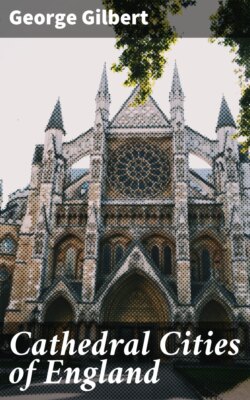Читать книгу Cathedral Cities of England - George Walker Gilbert - Страница 9
На сайте Литреса книга снята с продажи.
Оглавление
Licefelle.
("Doomsday Book.")
ICHFIELD, the ancient cathedral city of Staffordshire, has the best existing type of the fourteenth-century English church. It is memorable also as the birthplace of Dr. Johnson. Through the generosity of Alderman Gilbert the Corporation has purchased the house in which Dr. Johnson was born, with his statue opposite it, and has opened it to the public, much in the same way as that of Shakespeare's at Stratford-on-Avon. Lichfield is about sixteen miles to the north of Birmingham, and lies in a fertile valley, on a small tributary of the Trent.
The Venerable Bede, in his accounts of this city, calls it Licidfeld, being supposed to mean "Field of the Dead." It appears that a large number of Christians, in the reign of Diocletian, was massacred just in the neighbourhood, and thus originated the name Lichfeld, now altered to Lichfield. The termination "feld" was clearly introduced from over the water, for it still exists in the Low Countries, and bears the same meaning. As to what connection exists between "licid" and "dead," we cannot clearly understand.
In 669 Lichfield became an episcopal see, over which St. Chad was the first bishop. He left behind him a work, in the form of his Gospels. For a short time, namely, in the reign of Offa, it was raised to the dignity of an archbishopric, but the Primacy was restored to Canterbury in 803. The See of Lichfield was, in 1075, transferred to Chester, and from there, a few years later, to Coventry. Eventually, in 1148, Lichfield recovered its see. In 1305 the town received a charter of incorporation, and has since returned members to Parliament. It was raised to the dignity of a city by Edward VI., 1549.
The original Norman Cathedral no longer exists. In its stead there is a beautiful structure of Early English style, dating either from the end of the twelfth or the beginning of the thirteenth century.
Mr. Collins gives us an excellent idea of the wonderful and elaborate architecture of the west front. It seems that the architect generally lavished his best powers on the west front, as if to arrest the attention of the worshipper prior to entry. The west front was, and is now, invariably the chief entrance to the church. There is no doubt that the entrance was here specially situated with a view of continuing the first great impression. There is nothing grander and more impressive in cathedral architecture than to view the gradual unfolding of the interior as the sight becomes more accustomed to the sudden transition of the outside glare of day to the subdued light inside.
Nothing can be more symbolical of religion in church structure than to observe the trend of architectural lines in perspective. If the eye follow the upward course of the central and side aisles, and the downward sweep of the caps of columns, arches and walls diminishing in true perspective lines, it will be seen that they converge to the holiest place of the sacred edifice—the altar, the point of sight for all.
This Cathedral received, like other mighty buildings, similar ill-treatment during the Civil Wars. It was converted into stables by the parliamentary troops, who created havoc amongst its rich sculptures. In 1651 it was set on fire, and, by order of Parliament, was stripped of its lead, and left to neglect and decay.
The damage was repaired by Bishop Hackett in 1671. The Restoration has not long been completed, various improvements having been made. Under the superintendence of Mr. Wyatt, the choir was enlarged by the removal of the screen in front of the Lady Chapel. The transepts are richly ornamented, and contain certain portions of Norman architecture. The windows are worked in beautiful tracery. The choir is in the Decorated style of English architecture.
LICHFIELD THE WEST FRONT
St. Mary's Chapel is an elegant design by Bishop Langton. For the central window was painted "The Resurrection," by Eggington, from a design by Sir Joshua Reynolds, the first president of the Royal Academy. In this same chapel there was the rich shrine to St. Chad, which was demolished at the Dissolution.
There is a great central tower of two hundred and eighty-five feet in height, besides two western spires one hundred and eighty-three feet. The total length of the building from east to west is about four hundred feet. By the north aisle is the Chapter-house. It is a ten-sided building of great beauty, with a vaulted roof supported on a central clustered column.
The memory of Bishops Hackett, Langton, and Pattishul is kept alive by their monuments, which escaped the ravages of Cromwell's troops. A monument to Dr. Samuel Johnson, a bust of Garrick, and a mutilated statue of Captain Stanley, serve to remind us of their departure from this world. Chantrey is responsible for a monument to the memory of the infant children of Mrs. Robinson.
